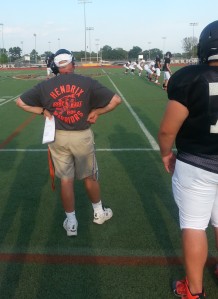
I’ve had a couple recent pieces out on the Hendrix football program, which will have its first game this Saturday since 1960. One is an article in the Arkansas Democrat-Gazette, the other is a Q&A with Karen Tricot-Steward of KUAR 89.1 FM.
Here’s an expanded version of my article’s beginning:
In cinema, this has been the summer of the rehash: Iron Man 3, Despicable Me 2, Man of Steel, Monsters University, Fast & Furious 6. A glance down the list of top-grossing movies of 2013 makes no bones about it—when there’s money to be made, nothing more dependably does the job than going with the tried and true. Turns out, this line of thinking also applies to the world of higher education. Many small liberal-arts colleges across the nation shuttered their football programs in the 1940s, ’50s and ’60s, in part to save money.
But in the last couple of decades, many of those same colleges have developed long-term growth plans that depend on a significant increase in student population and the attendant boost in revenue their tuition and board payments would bring. A new football team typically means an immediate infusion of 80-100 new students. Which can mean something in the vicinity of $3 million after those new football players’ tuition and board payments are totaled.
Vance Strange, a former Hendrix football player and current booster, said that it’s projected a roster of 65-70 Hendrix football players (the roster is currently 54) would annually produce about $1.8 – $1.9 million revenue for the school.
An all-time high of 12 U.S. colleges are starting or restarting football programs this fall, and Hendrix kicks off its new era in Conway against Missouri’s Westminster College. Although its program sputtered in the 1950s, Hendrix had a highly successful program in previous decades. It twice tied the University of Arkansas and lost in a 14-7 contest in 1926 that attracted 6,000 people—said to be the most spectators to attend a sports event in Arkansas to that point. In 1913, the Hendrix Bulldogs beat Ole Miss 8-6…
You can read the rest of the Arkansas Democrat-Gazette article here. [paywall warning]
To me, one of the most unique aspects of early 20th century football was how openly boosters gave gifts to student-athletes. Back in the day, though, hooking a star player up with goodies was common. As I wrote:
Now: The National Collegiate Athletic Association forbids its student-athletes from receiving payments or gifts from boosters—supporters who donate to the player’s program. The college athlete is supposed to be an amateur, and such payments jeopardize what the NCAA defines as amateur status.
Then: The NCAA was in its infancy and Hendrix, like hundreds of other football-playing schools across the nation, wasn’t a member. Less bureaucracy surrounding the game meant fewer rules and less manpower to enforce them.
Case in point: In 1924, Hendrix football player Wright Salter received a knitted necktie from Keith’s Millinery Shop for blocking the first pass of an opponent during a Thanksgiving Day game, Lester wrote. Salter’s teammate Bill Meriwether won a fruitcake for his sterling play that same game.
I asked Bill Wilson, who played for Hendrix in 1959 and 1960, if he had ever heard about booster gift giving in the late 1950s. He said no, but did add that he heard it happened at what’s now Arkansas Tech University and Southern Arkansas University.
For more of my interviews with Wilson and Tricot-Steward, check out the KUAR 89.1 FM piece here.


